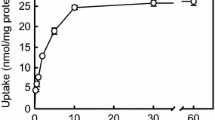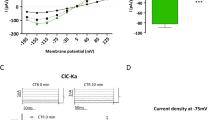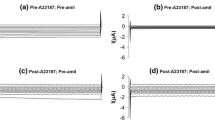Summary
We studied the mechanism of K++ channel activation by minoxidil-sulfate (MxSO4) in fused Madin-Darby canine kidney (MDCK) cells. Patch-clamp techniques were used to assess single channel activity, and fluorescent dye techniques to monitor cell calcium. A Ca+2+-dependent inward-rectifying K++ channel with slope conductances of 53±3 (negative potential range) and 20±3 pS (positive potential range) was identified. Channel activity is minimal in cell-attached patches. MxSO4 initiated both transient channel activation and an increase of intracellular Ca+2+ (from 94.2±9.1 to 475±12.6 nmol/liter). The observation that K++ channel activity of excised inside-out patches was detected only at Ca+2+ concentrations in excess of 10 μmol/liter suggests the involvement of additional mechanisms during channel activation by MxSO4.
Transient K++ channel activity was also induced in cell-attached patches by 10 μmol/liter of the protein kinase C activator 1-oleoyl-2-acetyl-glycerol (OAG). OAG (10 μmol/liter in the presence of 1.6 mmol/liter ATP) increased the Ca+2 sensitivity of the K+ channel in inside-out patches significantly by lowering the K mfor Ca+2 from 100 μmol/liter to 100 nmol/liter. The channel activation by OAG was reversed by the protein kinase inhibitor H8. Staurosporine, a PKC inhibitor, blocked the effect of MxSO4 on K+ channel activation. We conclude that MxSO4-induced K+ channel activity is mediated by the synergistic effects of an increase in intracellular Ca+2 and a PKC-mediated enhancement of the K+ channel's sensitivity to Ca+2.
Similar content being viewed by others
References
Bell, R.M. 1986. Protein kinase C activation by diacetylglycerol second messengers. Cell 45:631–632
Bólivar, J.J., Cereijido, M. 1987. Voltage and Ca+2 activated K+ channel in cultured epithelial cells (MDCK). J. Membrane Biol. 97:43–51
Dunne, M.J., Yule, D.I., Gallacher, D.V., Petersen, O.H. 1989. Cromakalim (BRL 34915) and diazoxide activate ATPregulated potassium channels in insulin-secreting cells. Pfluegers Arch. 414 (Suppl. 1):S154-S155
Escande, D., Thuringer, D., Le Guern, S., Courteix, J., Laville, M., Cavero, I. 1989. Potassium channel openers act through an activation of ATP-sensitive K+ channels in guinea-pig cardiac myocytes. Pfluegers Arch. 414:669–675
Fan, Z., Nakayama, K., Hiraoka, M. 1990. Multiple actions of pinacidil on adenosine triphosphate-sensitive potassium channels in guinea-pig ventricular myocytes. J. Physiol. 430:273–295
Friedrich, F., Paulmichl, M., Kolb, H.A., Lang, F. 1988. Inward rectifier K channels in renal epithelioid cells (MDCK) activated by serotonin. J. Membrane Biol. 106:149–155
Friedrich, F., Weiss, H., Paulmichl, M., Lang, F. 1989. Activation of potassium channels in renal epithelioid cells (MDCK) by extracellular ATP. Am. J. Physiol. 256:C1016-C1021
Frindt, G., Palmer, L.G. 1989. Low-conductance K+ channels in apical membrane of rat cortical collecting tubule. Am. J. Physiol. 256:F143-F151
Grynkiewicz, G., Ponie, M., Tsien, R.Y. 1985. A new generation of Ca+2 indicators with greatly improved fluorescence properties. J. Biol. Chem. 260:3440–3450
Hamill, O.P., Marty, A., Neher, E., Sakmann, B., Sigworth, F.J. 1981. Improved techniques for high-resolution current recording from cell-free membrane patches. Pfluegers Arch. 391:85–100
Hannun, Y.A., Bell, R.M. 1990. Rat brain protein kinase C. J. Biol. Chem. 265:2962–2972
Hays, R.S., Baum, M., Kokko, J.P. 1987. Effects of protein kinase C activation on sodium, potassium, chloride and total CO2 transport in the rabbit corticol collecting tubule. J. Clin. Invest. 80:1561–1570
Hidaka, H., Inagaki, M., Kawamoto, S., Sasaki, Y. 1984. Isoquinolinesulfonamides, novel and potent inhibitors of cyclic nucleotide dependent protein kinase and protein kinase C. Biochemistry 23:5036–5041
Honoré, E., Lazdunski, M. 1991. Hormone-regulated K+ channels in follicle-enclosed oocytes are activated by vasorelaxing K+ channel openers and blocked by antidiabetic sulfonylureas. Proc. Natl. Acad. Sci. USA 88:5438–5442
Humphrey, S.J., Zins, G.R. 1984. Whole body and regional hemodynamic effects of minoxidil in the conscious dog. J. Cardiovasc. Pharmacol. 6:979–988
Kersting, U., Joha, H., Steigner, W., Gassner, B., Gstraunthaler, G., Pfaller, W., Oberleithner, H. 1989. Fusion of cultured dog kidney (MDCK) cells:I. technique, fate of plasma membranes and of cell nuclei. J. Membrane Biol. 111:37–48
Kersting, U., Wojnowski, L., Steigner, W., Oberleithner, H. 1991. Hypotonic stress-induced release of KHCO3 in fused renal epithelioid cells (MDCK). Kidney Int. 39:891–900
Lang, F., Paulmichl, M., Pfeilschifter, J., Friedrich, F., Wöll, E., Waldegger, S., Ritter, M., Tschernko, E. 1991. Cellular mechanisms of bradykinin-induced hyperpolarization in renal epithelioid MDCK-cells. Biochimica Biophysica Acta 1073:600–608
Leblanc, N., Wilde, D.W., Keef, K.D., Hume, J. 1989. Electrophysiological mechanisms of minoxidil sulfate-induced vasodilation of rabbit portal vein. Circ Res. 65:1102–1111
Linas, S.L., Nies, A.S. 1981. Minoxidil. Ann. Int. Med. 94:61–65
Madin, S.H., Darby, N.B. 1958. CCL-34. As catalogued in: American Type Culture Collection Catalogue of Strains. 2:574–576
May, W.S., Sahyoun, N., Wolf, M., Cuatrecasas, P. 1985. Role of intracellular calcium mobilization in the regulation of protein kinase C-mediated membrane processes. Nature 317:549–551
Meisheri, K.D., Cipkus, L.A., Taylor, C.A. 1988. Mechanism of action of minoxidil sulfate-induced vasodilation: A role for increased K+ permeability. J. Pharm. Exp. Ther. 245:751–760
Oberleithner, H., Vogel, U., Kersting, U., Steigner, W. 1990. Madin-Darby kidney cells. II. Aldosterone stimulates Na+/H+ and Cl+−/HCO3 +− exchange. Pfluegers Arch. 416:533–539
Paulmichl, M., Pfeilschifter, J., Wöll, E., Lang, F. 1991. Cellular mechanism of ATP-induced hyperpolarization in renal epithelioid MDCK-cells. J. Cell. Physiol. 147:68–75
Rittenhouse-Simmons, S., Deykin, D. 1978. The activation by Ca+2 of platelet Phospholipase A2. Effects of dibutyryl cyclic AMP and 8-(N,N-diethylamino)-octyl-3,4,5-trimethoxybenzoate. Biochim. Biophys. Acta 543:409–422
Salomao, L., Wark, G., Dubinsky, W.P., Schultz, S.G. 1992. Effect of trypsin on a Ca+2-activated K+ channel reconstituted into planar phospholipid bilayers. Am. J. Physiol. 262:C971-C974
Shearman, M.S., Sekiguchi, K., Nishizuka, Y. 1989. Modulation of ion channel activity: A key function of the protein kinase C enzyme family. Pharmacol. Rev. 41: 211–237
Schwab, A., Westphale, H.-J., Wojnowski, L., Wünsch, S., Oberleithner, H. 1992. Spontaneously K+ channel activity in transformed Madin-Darby Canine Kidney cells. J. Clin. Invest. (submitted)
Standen, N.B., Quayle, J.M., Davies, N.W., Brayden, J.E., Huang, Y., Nelson, M.T. 1989. Hyperpolarizing vasodilators activate ATP-sensitive K+ channels in arterial smooth muscle. Science 245:176–180
Thuringer, D., Escande, D. 1989. Apparent competition between ATP and the potassium channel opener RP 49356 on ATP-sensitive K+ channels of cardiac myocytes. Mol. Pharmacol. 36:897–902
Valentich, J.D. 1981. Morphological similarities between the dog kidney cell line MDCK and the mammalian cortical collecting tubule. Ann. New York Acad. Sci. 81:384–405
Wang, W., Giebisch, G. 1991. Dual modulation of renal ATP-sensitive K+ channel by protein kinases A and C. Proc. Natl. Acad. Sci. USA 88:9722–9725
Wang, W., Giebisch, G. 1991. Dual effects of ATP on apical small conductance K+ channel of the rat cortical collecting duct. J. Gen. Physiol. 98:35–61
Wang, W., Schwab, A., Giebisch, G. 1990. Regulation of small-conductance K+ channel in apical membrane of rat cortical collecting tubule. Am. J. Physiol. 259:F494-F502
Weik, R., Neumcke, B. 1990. Effects of potassium channel openers on single potassium channels in mouse skeletal muscle. Naunyn-Schmiedeberg's Arch. Pharmacol. 342:258–263
Weiss, H., Friedrich, F., Paulmichl, P., Wöll, E., Lang, F. 1991. Effect of BHT 920 on calcium-activated K+ channels in renal epithelioid MDCK cells. Biochim. Biophys. Acta 1069:165–170
Weston, A.H. 1989. Smooth muscle K+ channel openers; their pharmacology and clinical potential. Pfluegers Arch. 414 (Suppl. 1):S99-S105
Winquist, R.J., Heaney, L.A., Wallace, A.A., Baskin, E.P., Stein, R.B., Garcia, M.L., Kaczorowski, G.J. 1989. Glyburide blocks the relaxation response to BRL 34915 (Cromakalim), minoxidil sulfate and diazoxide in vascular smooth muscle. J. Pharm. Exp. Ther. 248:149–156
Wolf, M., Levine, H., May, W.S., Cuatrecasas, P., Sahyoun, N. 1985. A model for intracellular translocation of protein kinase C involving synergism between Ca+2 and phorbol esters. Nature 317:546–549
Author information
Authors and Affiliations
Additional information
A. Schwab was recipient of a Feodor-Lynen-Fellowship from the Alexander von Humboldt-Stiftung. This work was supported by NIH grant DK 17433. The authors thank Nikon Instruments Partners in Research Program for their support and generous use of equipment during the course of this study. Minoxidil-sulfate was kindly provided by Upjohn, Kalamazoo, MI.
Rights and permissions
About this article
Cite this article
Schwab, A., Geibel, J., Wang, W. et al. Mechanism of activation of K++ channels by minoxidil-sulfate in Madin-Darby canine kidney cells. J. Membarin Biol. 132, 125–136 (1993). https://doi.org/10.1007/BF00239002
Received:
Revised:
Issue Date:
DOI: https://doi.org/10.1007/BF00239002




